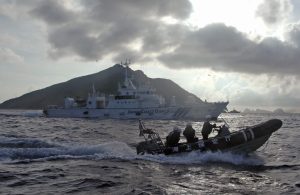On June 7, 2024, the Japan Broadcasting Corporation (NHK) reported that the Japan Coast Guard (JCG) is considering building its largest patrol vessel to date, capable of carrying numerous high-performance rubber boats and three helicopters, mainly for use in the Senkaku Islands area. The patrol vessel will reportedly have the ability to command other patrol vessels and is expected to serve as a base for guarding the waters around the islands.
If the new vessel is constructed, the plan is for it to not only handle situations in the waters around the islands but also to provide emergency transportation of residents and responses to natural disasters. The planned size of the new vessel is expected to be a total length of 200 meters, with gross tonnage of about 30,000 tons. That would make it about four times the size of the largest patrol vessel in the JCG’s current fleet. The plan is for the vessel to be in service in the 2029 fiscal year, five years from now.
Incursions by China Coast Guard (CCG) vessels into the waters around the Senkaku Islands are becoming routine, with CCG vessels approaching and chasing Japanese fishing boats and navigating Japan’s contiguous zone. Early last month, all four CCG vessels entering the territorial waters around the islands were confirmed to be carrying what appeared to be guns. By June 16, CCG vessels had sailed in the contiguous zone for 178 consecutive days, the longest continuous period since the Japanese government nationalized the Senkaku Islands.
China not only claims territorial rights over the Senkaku Islands but also operates and intensifies its activities in the waters around the islands.
It is also possible that CCG forces may land on the Senkaku Islands in the future. Moreover, considering the rise in CCG vessels approaching and chasing Japanese fishing boats, CCG forces may start attempting to enforce Chinese laws and regulations against Japanese fishing boats.
On December 16, 2022, the Japanese government published cabinet approval of the “National Security Strategy (NSS)” (the new NSS), which is the basic policy on national security. The NSS includes the phrase “possessing defense capabilities, which enable Japan to firmly defend itself on its own.” In the future, it will be necessary to make preparations so that Japan can proactively deal with any kind of situation that may occur around the Senkaku Islands, appropriately and effectively.
In recent years, CCG vessels have become larger and more heavily armed. Vessels belonging to the People’s Liberation Army (PLA) Navy have also been converted to CCG vessels through changes in outfitting and painting. According to data published by the JCG, the number of large CCG vessels at 1,000 tons or more (full-load displacement) was 131 as of the end of December 2020, more than triple that of a decade prior. That is about twice the number of large patrol vessels at 1,000 tons (gross tonnage) or more that the JCG has.
Some of the CCG vessels are equipped with 76mm guns, just like the destroyers of the Japan Maritime Self-Defense Force (JMSDF). The JCG’s Patrol Vessel Large with Helicopter (PLH) Akitsushima (150 meters long, about 6,500 tons gross tonnage) carries 40mm guns.
The JCG is also bolstering its maritime security system, and the construction of a new large patrol vessel is part of this effort. As of April 1, 2023, the JCG had a total of 19 PLHs (Patrol Vessels Large with Helicopter).
However, it is not possible for Japan to increase its number of large patrol vessels at the same rate and to the same extent as China. It goes without saying that the construction of large patrol vessels and the training of Coast Guard officers take time and money. Once the large patrol vessels have been constructed, Japan will also need to be able to reliably manage repairs, upkeep, crew, and fuel.
There is no way of knowing how long the tensions between Japan and China over the Senkaku Islands will continue. With the islands quite likely to remain a flashpoint over the next one or two decades, Japan will need to continue its commitment to bolstering its maritime law enforcement system. The building of a new patrol vessel for the JCG can be seen as part of this commitment.

































